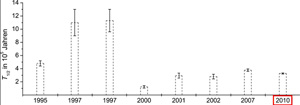Sep 6 2010
In order to estimate the safety of final storage for nuclear wastes, it is important to know the half-lives of the radioactive elements of the nuclear waste as accurately as possible.
The half-life indicates the period of time in which the amount of a radioactive element decreases by half and breaks down into other atoms. This period of time can, depending on the composition of the nuclear waste, amount to decades or even millions of years.
 Data on half-life of Selenium. (Credit: PTB)
Data on half-life of Selenium. (Credit: PTB)
In low and intermediate-level waste, the isotope 79selenium is found. Previous determinations of its half-life varied strongly between 124 000 and 1 130 000 years.
In order to be able to come to a more accurate conclusion here as to how long nuclear waste which contains this isotope will probably radiate, researchers from various institutes have joined forces: Scientists from the Physikalisch-Technische Bundesanstalt (PTB), the Lehrstuhl für Radiochemie (Institute for Radiochemistry) of the TU Munich, the Institut für Transurane (Institute for Transuranium Elements) in Karlsruhe and the Paul Scherrer Institute in Villingen (Switzerland) have now redetermined the half-life of 79selenium with a clearly improved measurement uncertainty to. Their result: 327 000 years.